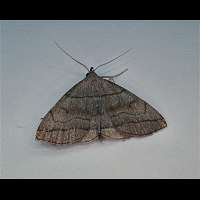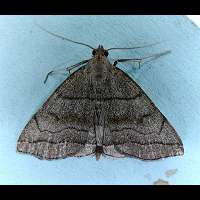Shaded Fan-foot Herminia tarsicrinalis
The Shaded Fan-foot is just one of the many Fan-feet and Snouts. And all Fan-feet and Snouts are weird creatures, for they are small and don't look like Owlet Moths at all. The snout seems to suggest a Snout Moth. The broad wings, which are kept parallel seem to point out one of the Geometer Moths, though. All Fan-feet and allies are rather similar. The easiest way of telling them apart is by looking at the lines in the wings, of which there are usually three. The Shaded Fan-foot is easily identified. The top line runs straight, except for an angle at the upperside of the wing. This line is followed by a broad dark smear: the shade from which the animal's common name was derived. This shade is not found in any other species of Fan-feet and Snouts. The colour is brownish, reddish brown or greyish brown. The wingspan is some 28 to 32mm only.
The first caterpillars of the Shaded Fan-foot are seen in July. They do not eat fresh leaves, but concentrate on withered leaves of the foodplant. They feed during the night and hide between the leaf litter during the day. In oktober the full-grown larva spins a cocoon between the fallen leaves and overwinters in it. Pupation takes place next spring within the same cocoon. The caterpillars are difficult to identify as they have hardly any specific characteristics. They are greyish brown and have a dark brown head with some lighter markings. There is a vague, dark dorsal line. The spiracula are black with a thin white ring around them. They grow to be some 17 to 20mm long. The larvae are fond of withered and fallen leaves of brambles. They will eat other leaflitter as well, especially leaves of oak and beech. When leaflitter is not available fresh leaves of low growing plants are eaten, such as the leaves of Dandelion.
The Shaded Fan-foot is single brooded and on the wing in June and July mainly. In southern parts of the continent this species is double-brooded. In spite of the climate change and some hot summers, this phenomenon has not been seen in Britain yet. The moths fly by night only and remain close to the foodplants. They are attracted to light, but not to sugar. Not the easiest of all photographer's models, as it has a tendency to take off all the time. A local species in Britain, found mainly in Suffolk, Norfolk and Essex. On the continent a common species wherever brambles grow.
The Shaded Fan-foot is just one of the many Fan-feet and Snouts. And all Fan-feet and Snouts are weird creatures, for they are small and don't look like Owlet Moths at all. The snout seems to suggest a Snout Moth. The broad wings, which are kept parallel seem to point out one of the Geometer Moths, though. All Fan-feet and allies are rather similar. The easiest way of telling them apart is by looking at the lines in the wings, of which there are usually three. The Shaded Fan-foot is easily identified. The top line runs straight, except for an angle at the upperside of the wing. This line is followed by a broad dark smear: the shade from which the animal's common name was derived. This shade is not found in any other species of Fan-feet and Snouts. The colour is brownish, reddish brown or greyish brown. The wingspan is some 28 to 32mm only.
The first caterpillars of the Shaded Fan-foot are seen in July. They do not eat fresh leaves, but concentrate on withered leaves of the foodplant. They feed during the night and hide between the leaf litter during the day. In oktober the full-grown larva spins a cocoon between the fallen leaves and overwinters in it. Pupation takes place next spring within the same cocoon. The caterpillars are difficult to identify as they have hardly any specific characteristics. They are greyish brown and have a dark brown head with some lighter markings. There is a vague, dark dorsal line. The spiracula are black with a thin white ring around them. They grow to be some 17 to 20mm long. The larvae are fond of withered and fallen leaves of brambles. They will eat other leaflitter as well, especially leaves of oak and beech. When leaflitter is not available fresh leaves of low growing plants are eaten, such as the leaves of Dandelion.
The Shaded Fan-foot is single brooded and on the wing in June and July mainly. In southern parts of the continent this species is double-brooded. In spite of the climate change and some hot summers, this phenomenon has not been seen in Britain yet. The moths fly by night only and remain close to the foodplants. They are attracted to light, but not to sugar. Not the easiest of all photographer's models, as it has a tendency to take off all the time. A local species in Britain, found mainly in Suffolk, Norfolk and Essex. On the continent a common species wherever brambles grow.





